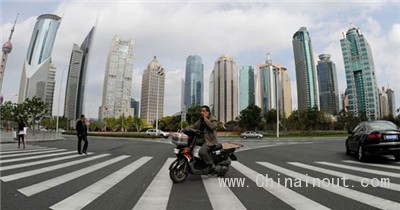堅(jiān)信中國崛起緣于國家強(qiáng)勢(shì)干預(yù)經(jīng)濟(jì)的批評(píng)人士為數(shù)不少,,由政策制定者和評(píng)論員們組成的這些批評(píng)者強(qiáng)烈譴責(zé)北京奉行的國家資本主義,。但他們的觀點(diǎn)是錯(cuò)誤的,而更糟的是,,他們可能引發(fā)短視和毫無建設(shè)性的回應(yīng),。
現(xiàn)實(shí)情況是,中國經(jīng)濟(jì)快速崛起是市場(chǎng)角色不斷擴(kuò)大和私營企業(yè)壯大的結(jié)果,。在一個(gè)實(shí)際規(guī)模擴(kuò)大了25倍的經(jīng)濟(jì)體中,,私營企業(yè)貢獻(xiàn)的產(chǎn)出比例,從1978年中國開始改革時(shí)的零,,升至如今的逾三分之二,。同期幾乎所有的就業(yè)增長均來自私營企業(yè)。私營企業(yè)還日益成為出口增長的主要貢獻(xiàn)因素,。
中國國有企業(yè)的角色,,在制造業(yè)收縮得尤其快——中國的制造業(yè)在上世紀(jì)80年代向私營企業(yè)放開了競(jìng)爭(zhēng),。國企在制造業(yè)所占產(chǎn)出份額現(xiàn)在只有五分之一,而在1978年則有五分之四,。人們普遍認(rèn)為,,自全球金融危機(jī)爆發(fā)以來,中國國有工業(yè)企業(yè)如今已經(jīng)復(fù)興,。實(shí)際上,,自2008年以來私營企業(yè)產(chǎn)出年均增長18%,是國企擴(kuò)張速度的兩倍,。
國有工業(yè)企業(yè)相對(duì)疲弱表現(xiàn)的深層根源在于生產(chǎn)率低下,。大多數(shù)投資資金來自留存利潤,因此資產(chǎn)回報(bào)率是國企兩倍多的私營工業(yè)企業(yè)能夠更為迅速地?cái)U(kuò)張,。大多數(shù)國有銀行的行為日益商業(yè)化,,讓私企更加如魚得水:在最近幾年里,它們向私企發(fā)放的貸款幾乎是發(fā)放給國企的兩倍,。
創(chuàng)建于2003年,、監(jiān)督各大國有非金融企業(yè)的中國國有資產(chǎn)監(jiān)督管理委員會(huì)(SASAC)或許是中國工業(yè)政策的最佳體現(xiàn)。批評(píng)人士稱,,國資委青睞大型國企,力圖創(chuàng)建更大,、更強(qiáng),、更加盈利豐厚的國家冠軍企業(yè)。但這種努力失敗了:自2007年以來國資委監(jiān)督企業(yè)的資產(chǎn)回報(bào)率大幅下降,,現(xiàn)在還不到其資本成本的一半,。
即便在被國資委確認(rèn)為北京要保持相對(duì)強(qiáng)有力控制的鋼鐵行業(yè),也體現(xiàn)出國企和私企之間的差距,。在2005年,,這似乎是一個(gè)輕松的任務(wù):當(dāng)時(shí)全國一半的鋼鐵由國企生產(chǎn),它們的效率與私企相當(dāng),。但是在2006年以后的幾年里,,年均產(chǎn)出增長率降至9%(該十年的頭幾年平均增長率超過20%),國企回報(bào)率大幅下降,。到2012年,,它們出現(xiàn)了虧損,產(chǎn)量份額下降至三分之一以下,。相比之下,,私營鋼鐵企業(yè)的資產(chǎn)回報(bào)率在2006年之后出現(xiàn)上升,在2011年達(dá)到逾10%的峰值后略有下降,。由于私營鋼企的投資是國企的兩倍,,它們的產(chǎn)量份額仍會(huì)繼續(xù)上升,。
私營企業(yè)興起的例外是在金融、電信,、其他高科技商業(yè)服務(wù)行業(yè),,以及油氣行業(yè)的上游領(lǐng)域。在制造業(yè),,私企現(xiàn)在的投資份額是國企的7倍,。但在服務(wù)業(yè),國企投資份額超過私企,,近幾年只是略有下降,。然而,私營服務(wù)提供商的生產(chǎn)率比國企高出一倍,,這表明資本配置嚴(yán)重不當(dāng),。
中國國企的地盤正在縮小,但因?yàn)樗鼈兊睦麧欉h(yuǎn)低于資本成本,,它們依然拖累了增長,。如果中國實(shí)施去年宣布的經(jīng)濟(jì)改革(尤其是打破除電網(wǎng)等自然壟斷業(yè)務(wù)以外的一切壟斷),讓市場(chǎng)成為資源配置的決定性因素,,私企將取代國企在服務(wù)業(yè)的角色,。這將讓中國保持相對(duì)高速的經(jīng)濟(jì)增長,從而繼續(xù)其作為全球增長主要驅(qū)動(dòng)因素的角色,。那些對(duì)中國崛起有著根本性誤解并據(jù)此制定政策和作出預(yù)測(cè)的人很可能錯(cuò)失機(jī)遇,。
注:本文作者是彼得森國際經(jīng)濟(jì)研究所(Peterson Institute)研究員,著有《市場(chǎng)高于毛澤東:中國私營企業(yè)的崛起》(Markets over Mao, the Rise of Private Business in China)一書,。
(更多全球資訊請(qǐng)關(guān)注中國進(jìn)出口網(wǎng))

There is no shortage of critics who confidently attribute China’s rise to the forceful intervention of the state in the economy. But the ranks of policy makers and commentators decrying Beijing’s brand of state capitalism are wrong – and, worse, they risk provoking short-sighted and counterproductive responses.
The reality is that China’s rapid economic ascent is the result of the expanding role of the market and the rise of private businesses. Private companies now account for more than two-thirds of output, up from nothing when reform began in 1978, in an economy that has expanded 25 times in real terms. They account for almost all employment growth in the same period. Private companies are also increasingly the leading contributors to export growth.
State companies’ shrinking role has been particularly rapid in manufacturing, which opened up to competition from private businesses in the 1980s. State enterprises’ share of output in the sector is now only a fifth, compared with four-fifths in 1978. Conventional wisdom says state industrial companies have enjoyed a resurgence since the onset of the global financial crisis. In fact, the growth in output of private businesses since 2008 has averaged 18 per cent, twice the pace of expansion of state businesses.
Underlying the relatively poor performance of state industrial companies is low productivity. Most investment is financed with retained earnings – so private industrial businesses, with a return on assets more than twice that of state companies, can expand more rapidly. This is reinforced by the increasingly commercial behaviour of mostly state-owned banks: in recent years they have lent almost twice as much to private as to state companies.
China’s industrial policy is perhaps exemplified best by the State-Owned Assets Supervision and Administration Commission, created in 2003 to oversee the largest state-owned non-financial enterprises. Critics say it favours state companies in an attempt to create national champions that are larger, more powerful and more profitable. But this has failed: the return on assets of Sasac’s companies has plummeted since 2007, and is now below half their cost of capital.
The disparity between state and private companies is evident even in the steel industry, identified by Sasac as one industry in which Beijing was to maintain relatively strong control. This seemed an easy task in the mid-2000s, when state companies produced half of all steel output and their efficiency matched that of private companies. But when the annual growth in output fell to an average of just 9 per cent after 2006, compared with its average pace of more than 20 per cent earlier in the decade, state companies’ returns fell sharply. By 2012 they were in the red, and their share of production had fallen below a third. In contrast, the return on assets of private steel companies rose after 2006, reaching a peak of over 10 per cent in 2011 before declining slightly. With private steel companies investing more than twice as much as their state counterparts, their rising output share will continue.
The exception to the rise of private business is in finance, telecoms and other high-tech business services, as well as in upstream oil and gas. In manufacturing, private companies now account for seven times more investment than state ones. But in services the share of state companies’ investment exceeds that of private companies and has declined only very slightly in recent years. Yet the productivity differential favours private service providers by a margin of two to one over state enterprises, suggesting a substantial misallocation of capital.
The footprint of state companies is shrinking but, because they earn far less than their cost of capital, they remain a drag on growth. If China enacts economic reforms announced last year – particularly eliminating all but natural monopolies such as power distribution – and making the market the decisive factor in the allocation of resources, private businesses will displace state enterprises in services. That would allow China to sustain a relatively high rate of growth and thus to continue its role as a leading driver of global growth. Those who make policies and predictions based on a fundamental misunderstanding of China’s ascent are likely to miss out.
The writer is a fellow at the Peterson Institute for International Economics and author of ‘Markets over Mao: The Rise of Private Business in China’
(更多全球資訊請(qǐng)關(guān)注中國進(jìn)出口網(wǎng))











